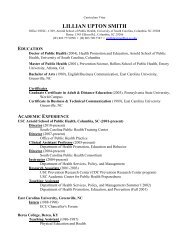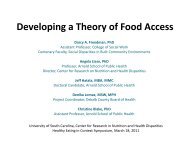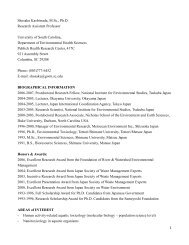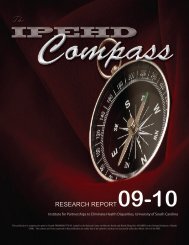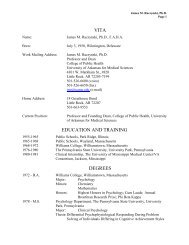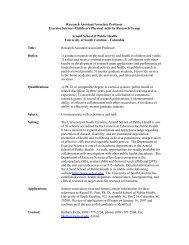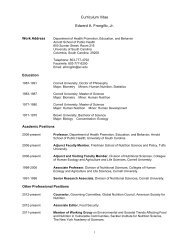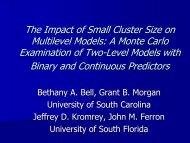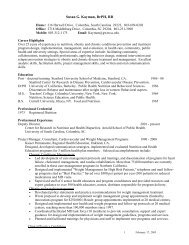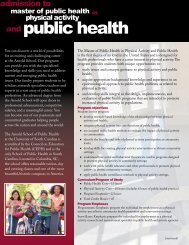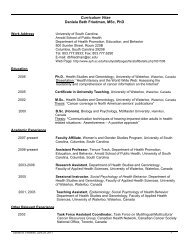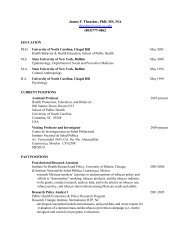HealthBeat - Arnold School of Public Health - University of South ...
HealthBeat - Arnold School of Public Health - University of South ...
HealthBeat - Arnold School of Public Health - University of South ...
You also want an ePaper? Increase the reach of your titles
YUMPU automatically turns print PDFs into web optimized ePapers that Google loves.
Breaking NewshealthbeatImproving People’s <strong>Health</strong> . . . Statewide and Worldwidearnold school <strong>of</strong> public health • university <strong>of</strong> south carolinaFALL 2007Tom Chandler NamedInterim Dean <strong>of</strong> <strong>Arnold</strong><strong>School</strong> <strong>of</strong> <strong>Public</strong> <strong>Health</strong>Tom Chandler, who has been ENHS chairfor nine years, will serve as interim deanwhile a national search is launched for areplacement for Dr. Donna Richter who hasleft her position as dean to become executivedirector <strong>of</strong> the <strong>South</strong> Carolina <strong>Public</strong><strong>Health</strong> Institute.“Tom is an extremely well qualified administratorfor the interim position,” said HarrisPastides, USC vice president for Researchand <strong>Health</strong> Sciences, adding Chandler alsois a nationally recognized researcher in theeffects <strong>of</strong> endocrine disrupting chemicalsand the effects <strong>of</strong> nano materials in theenvironment.Chandler is a member <strong>of</strong> the Delta Omega<strong>Public</strong> <strong>Health</strong> Honor Society and was the1997 recipient <strong>of</strong> the <strong>Arnold</strong> <strong>School</strong> <strong>of</strong><strong>Public</strong> <strong>Health</strong> Research Award for outstandingresearch accomplishments. In 1998, hereceived the USC Educational FoundationResearch Award in <strong>Health</strong> Sciences.In addition to his accomplishments on campus,he is one <strong>of</strong> three U.S. delegates to theenvironmental directorate (toxicity testingdivision) <strong>of</strong> the Organization for EconomicCooperation and Development (OECD) inParis – a global environmental protectioncoordinating agency for the developed anddeveloping world.Chandler is actively involved in developingand validating internationally standardizedtest methods for the OECD for evaluatingrisks <strong>of</strong> reproductively toxic chemicals inaquatic systems. He holds major competitivefunding from the USEPA, the NSF, andNOAA.Chandler grew up in Hamlet, N.C., studiedmarine sciences at UNC-Wilmington,earned his master’s and doctoral degreesfrom Louisiana State <strong>University</strong>, and joinedthe USC faculty in 1988 as a postdoctoralfellow at the Belle W. Baruch Institute. In1992 he moved to the Department <strong>of</strong> Environmental<strong>Health</strong> Sciences.New Faculty Bring aVariety <strong>of</strong> Talents andSkills to the <strong>School</strong>Nine new employees began their careers as tenure-track faculty in the <strong>Arnold</strong> <strong>School</strong>this fall. Five <strong>of</strong> them are in the Department <strong>of</strong> <strong>Health</strong> Promotion, Education, andBehavior (HPEB).They come from right here in our school and as far away as the <strong>University</strong> <strong>of</strong> Newfoundland.They each bring with them a set <strong>of</strong> skills and research skills that will onlyenhance the talent that already exists in the school. Here is a briefintroduction.Dr. Lucy AnnangDr. Clare BarringtonDr. Sonya J. Jones, a research assistant pr<strong>of</strong>essor and deputy director<strong>of</strong> the Center for Research in Nutrition and <strong>Health</strong> Disparities, andDr. Heather M. Brandt, a research assistant pr<strong>of</strong>essor and co-investigatorin the <strong>South</strong> Carolina Cancer Disparities Community Network,are already on the HPEB roster. They began their tenure-trackappointments in August.Jones earned a bachelor’s degree in Latin American Studies fromthe <strong>University</strong> <strong>of</strong> North Carolina at Chapel Hill. She also earned adoctorate in nutrition from UNC-Chapel Hill. She was an assistantpr<strong>of</strong>essor in the Department <strong>of</strong> Nutrition at the <strong>University</strong> <strong>of</strong> Tennessee,Knoxville before coming to USC in September 2005.An Iowa native, Brandt earned a bachelor’s degree in health promotionfrom the <strong>University</strong> <strong>of</strong> Iowa in Iowa City. She came to Columbiain 1997 where she earned her master’s and doctorate degrees inHPEB from the <strong>Arnold</strong> <strong>School</strong>. Brandt’s research interests includecancer disparities among underserved populations, cancer preventionand control, and human papillomavirus (HPV)-associatedcancers.Dr. Katrina M. Walsemann comes to USC from the <strong>University</strong> <strong>of</strong>Michigan Population Studies Center where she has been a NationalInstitutes on Aging postdoctoral research fellow. She earned herbachelor’s degree in psychology from the <strong>University</strong> <strong>of</strong> California-Davis and her master’s degree and doctorate in <strong>Health</strong> Behavior and<strong>Health</strong> Education from the <strong>University</strong> <strong>of</strong> Michigan <strong>School</strong> <strong>of</strong> <strong>Public</strong><strong>Health</strong>.Dr. Clare Barrington has been a research assistant and study coordinatorat the Johns Hopkins Bloomberg <strong>School</strong> <strong>of</strong> <strong>Public</strong> <strong>Health</strong> inBaltimore where she recently earned her doctorate from the Department<strong>of</strong> International <strong>Health</strong>. She also earned a master’s degreeDr. Heather M.Brandtfrom the same department and a bachelor’s degree with a concentrationin International <strong>Health</strong> and Development Studies from Brown <strong>University</strong>.continued on page 18<strong><strong>Health</strong>Beat</strong> • Fall 07• 1
message from thedean . . .We are makingGREAT stridesin communityengagement.To help fosterinnovations thatcan improve thepublic’s health in<strong>South</strong> Carolina,researchersin the <strong>Arnold</strong><strong>School</strong> havecollaborated withthe Department<strong>of</strong> <strong>Health</strong> andEnvironmentalControl to createthe <strong>South</strong> Carolina<strong>Public</strong> <strong>Health</strong>Consortium.As many <strong>of</strong> you know by now, Donna Richter has left the dean’s position to become the executive director <strong>of</strong> the <strong>South</strong> Carolina<strong>Public</strong> <strong>Health</strong> Institute. We will miss her leadership and direction, but wish her the best in her new role. (See story on page 18.)This fall will be a time <strong>of</strong> change for many <strong>of</strong> us as we launch the search for the school’s permanent dean.Beyond the administrative changes that are taking place in the dean’s <strong>of</strong>fice, the fall semester is a time <strong>of</strong> change and renewal foreveryone at the <strong>Arnold</strong> <strong>School</strong>. As the new crop <strong>of</strong> students and faculty begin arriving on campus, the halls are filled with anexciting buzz <strong>of</strong> activity. But fall is not just a time for new beginnings, it is a time to reflect on the successes and contributionsthe faculty, staff, and students have made over the last year. The <strong>Arnold</strong> <strong>School</strong> is a GREAT school <strong>of</strong> public health. It is on thecutting edge in community involvement, leadership, research, and teaching. The people who make up our school are a wonderfulresource for the local community, the state, and the nation. We can be proud <strong>of</strong> the positive impact they make on peoples livesevery single day.We are making GREAT strides in community engagement. To help foster innovations that can improve the public’s health in<strong>South</strong> Carolina, researchers in the <strong>Arnold</strong> <strong>School</strong> have collaborated with the Department <strong>of</strong> <strong>Health</strong> and Environmental Control tocreate the <strong>South</strong> Carolina <strong>Public</strong> <strong>Health</strong> Consortium. The consortium will receive $50,000 a year for two years in matching fundsfrom the Robert Wood Johnson Foundation to support their efforts. The consortium is a nonpr<strong>of</strong>it, multi-sector entity that worksin partnership and collaboration with federal, state, and local public health agencies, universities, foundations, and other healthrelatedorganizations to foster innovations that improve community health.We are making GREAT advances in research and teaching. This fall nine new faculty with varied interests and backgrounds willbegin as tenure-track faculty in the school. Five <strong>of</strong> the new members are in the Department <strong>of</strong> <strong>Health</strong> Promotion, Education, andBehavior. Dr. Sonya J. Jones, will be an assistant pr<strong>of</strong>essor and deputy director <strong>of</strong> the Center for Research in Nutrition and <strong>Health</strong>Disparities, and Dr. Heather M. Brandt, a research assistant pr<strong>of</strong>essor and co-investigator in the <strong>South</strong> Carolina Cancer DisparitiesCommunity Network, are already on the HPEB roster. They have received tenure-track appointments that began in August.Dr. Katrina M. Walsemann comes to USC from the <strong>University</strong> <strong>of</strong> Michigan Population Studies Center where she has been aNational Institutes on Aging postdoctoral research fellow. Dr. Clare Barrington has been a research assistant and study coordinatorat the Johns Hopkins Bloomberg <strong>School</strong> <strong>of</strong> <strong>Public</strong> <strong>Health</strong> in Baltimore where she recently earned her doctorate from theDepartment <strong>of</strong> International <strong>Health</strong>. Dr. Lucy Annang has been an assistant pr<strong>of</strong>essor at the <strong>University</strong> <strong>of</strong> Alabama at BirminghamDepartment <strong>of</strong> <strong>Health</strong> Behaviors and an associate scientist in the Minority <strong>Health</strong> and Research Center. Dr. Matthew Kostek, whois joining the <strong>Arnold</strong> <strong>School</strong>’s Department <strong>of</strong> Exercise Science, was a postdoctoral fellow at the Children’s National Medical Centerin Washington where he studied the molecular and genetics aspects <strong>of</strong> skeletal muscle.Drs. Jiajia Zhang and Hongmei Zhang are joining the faculty <strong>of</strong> the <strong>Arnold</strong> <strong>School</strong>’s Department <strong>of</strong> Epidemiology and Biostatistics.Jiajia Zhang comes from the Memorial <strong>University</strong> <strong>of</strong> Newfoundland in St. John’s, Newfoundland, Canada where she completedher doctoral studies and presented her dissertation in June. Her research interests include accelerated failure time models, frailtymodel, mixture cure models, statistical computation and semi-parametric estimation methods.Hongmei Zhang has been anassistant pr<strong>of</strong>essor in the Department <strong>of</strong> Mathematics and Statistics at the <strong>University</strong> <strong>of</strong> West Florida in Pensacola. Her researchinterests are statistics in bioinformatics, statistical methodology development, statistical modeling, and Bayesian data analyses.Dr. Sean Norman joined the tenure-track faculty <strong>of</strong> the Department <strong>of</strong> Environmental <strong>Health</strong> Sciences in August. Sean hasserved recently as interim director <strong>of</strong> the new Environmental Genomics Core Laboratory housed in the <strong>Arnold</strong> <strong>School</strong> (a $2.5million dollar state-<strong>of</strong>-the-art center for genome-based research). He is a molecular environmental microbiologist with interestsin bacterial metagenomics and its application to public health. I also congratulate Sean on his recent receipt <strong>of</strong> a prestigious$750K NSF grant in environmental microbiology with his co-PI Dr. Alan Decho <strong>of</strong> ENHS (feature to follow in the next issue <strong>of</strong><strong><strong>Health</strong>Beat</strong>).And finally, we are making GREAT advances in leadership across the state and the nation. Dr. Edward A. Frongillo, a pr<strong>of</strong>essorin the Department <strong>of</strong> <strong>Health</strong> Promotion, Education, and Behavior, has been named to a group <strong>of</strong> leading health expertssupporting greater U.S. public and private investment in global health research. Frongillo joins 50 colleagues as an ambassador inResearch!America’s Paul G. Rogers Society for Global <strong>Health</strong> Research.Dr. Russell Pate, USC associate vice president for health sciences and pr<strong>of</strong>essor in the Department <strong>of</strong> Exercise Science, has beennamed to the U.S. <strong>Health</strong> and Human Services advisory committee helping develop the first federal guidelines on physical activity.Dr. Deborah M. Parra-Medina, associate pr<strong>of</strong>essor in the <strong>Arnold</strong> <strong>School</strong>’s Department <strong>of</strong> <strong>Health</strong> Promotion, Education, andBehavior, has been honored with a 2007 <strong>South</strong> Carolina Women <strong>of</strong> Achievement Award for promoting the health and well-being<strong>of</strong> women.Drs. James Hebert and Heather Brandt <strong>of</strong> the <strong>Arnold</strong> <strong>School</strong> <strong>of</strong> <strong>Public</strong> Heath are among four pr<strong>of</strong>essionals and one organizationhonored recently for their work in cancer control by the <strong>South</strong> Carolina Cancer Alliance.These are only a few <strong>of</strong> the successes <strong>of</strong> the faculty, staff and students in the <strong>Arnold</strong> <strong>School</strong>. I am very pleased to be a part <strong>of</strong> the<strong>School</strong>’s administration as the search for a new dean begins. 2006/07 set a remarkably high bar for research, teaching and clinicalproductivity in the school. With everyone’s continuing dedication and hard work, I have every confidence that 2007/08 will beanother successful and productive year. I am looking forward to working with each <strong>of</strong> you.G. Thomas ChandlerInterim Dean, <strong>Arnold</strong> <strong>School</strong> <strong>of</strong> <strong>Public</strong> <strong>Health</strong><strong><strong>Health</strong>Beat</strong> • Fall 07• 3
<strong>Arnold</strong> Faculty recognized for outstanding workPate named to HHS advisorycommittee on federal physicalactivity guidelinesDr. Russell Pate, USC associate vice presidentfor health sciences and pr<strong>of</strong>essor in theDepartment <strong>of</strong> Exercise Science, has been namedto the U.S. <strong>Health</strong> and HumanServices advisory committeehelping develop the first federalguidelines on physical activity.The Physical Activity Guidelinesfor Americans is to be issued inlate 2008. The report will providescience-based recommendationson the latest knowledgeabout activity and health, withdepth and flexibility to targetDr. Russell Patespecific population subgroups,such as seniors, children, and persons with disabilities,said HHS Secretary Mike Leavitt.Pate is a nationally respected expert on theoverall health implications <strong>of</strong> physical activityand, specifically, youth fitness. He has publishedmore than 170 scholarly papers and authoredor edited five books. He coordinated the effortthat led to the Centers for Disease Control andPrevention/American College <strong>of</strong> Sports Medicinerecommendations on Physical Activity and <strong>Public</strong><strong>Health</strong> in 1995. He also served on an Institute<strong>of</strong> Medicine panel to develop guidelines on theprevention <strong>of</strong> childhood obesity and on the 2005Dietary Guidelines Advisory Committee.In addition, Pate is a former member <strong>of</strong> the scienceboard <strong>of</strong> the President’s Council on PhysicalFitness and Sports and a former president<strong>of</strong> American College <strong>of</strong> Sports Medicine. Hehas held leadership positions with the NationalCoalition on Promoting Physical Activity, theAmerican Academy <strong>of</strong> Kinesiology and PhysicalEducation, and the American Heart Association.Pate ran three U.S. Olympic Trials marathonsand twice finished in the top ten in the BostonMarathon.Parra-Medina honored with2007 <strong>South</strong> Carolina Women <strong>of</strong>Achievement AwardDr. Deborah M. Parra-Medina, associatepr<strong>of</strong>essor in the <strong>Arnold</strong> <strong>School</strong>’s Department <strong>of</strong><strong>Health</strong> Promotion, Education,and Behavior, has been honoredwith a 2007 <strong>South</strong> CarolinaWomen <strong>of</strong> Achievement Awardfor promoting the health andwell-being <strong>of</strong> women.Parra-Medina was among fivewomen recognized for outstandingachievements by the S.C.Commission at the third annualconference, “A Seat at the Table,”sponsored by the Columbia CollegeAlliance for Women.Dr. Deborah M.Parra-MedinaIn its nomination <strong>of</strong> Parra-Medina, the USCWomen’s Studies Program and PartnershipCouncil stated, “As an American child <strong>of</strong> Mexicanimmigrants, her life’s work is to illuminatethe roles <strong>of</strong> race, ethnicity, class, and gender inhealth and health behaviors, particularly in theLatino communities <strong>of</strong> the U.S. and to advocatefor the health and education <strong>of</strong> families <strong>of</strong> lowersocio-economic status.”After receiving her doctorate in epidemiologyin 1998, Parra-Medina and her family relocatedfrom San Diego to the <strong>University</strong> <strong>of</strong> <strong>South</strong> Carolinawhere she received the first joint appointmentin Women’s Studies and the <strong>Arnold</strong> <strong>School</strong>.During Parra-Medina’s career at USC she hashelped build a statewide network <strong>of</strong> Latinos whoare working on health issues. She also has beenthe principal investigator on eight major USCresearch grants totaling over $3.3 million, andshe has served as a co-investigator on numerousothers.She was a major contributor on the West ColumbiaProject, a collaborative research effort<strong>of</strong> Women’s Studies core faculty and the WestColumbia community to promote the empower-4 • Fall 07 • <strong><strong>Health</strong>Beat</strong>
ment, health and well-being <strong>of</strong> womenand girls in the area.Parra-Medina has been an advisor on theMinority Mentoring Planning Project forthe National Cancer Institute and hasserved on numerous university, department,and program committees.In 2005, Parra-Medina was presentedthe Most Influential Latino Award forOutstanding Service to the Latino Communityin <strong>South</strong> Carolina. She was giventhe award for her work as a role modeland mentor to young Latinos by theHispanic Leadership Council. In 2002,she received the Faculty Service Awardby the <strong>Arnold</strong> <strong>School</strong>, the CommunityService Award by the <strong>South</strong> Carolina <strong>Public</strong><strong>Health</strong> Association and the Women’sStudies Faculty Teaching Award.Frongillo named to panel <strong>of</strong>experts supporting greaterrole for U.S. in global healthresearchDr. Edward A. Frongillo, a pr<strong>of</strong>essor inthe Department <strong>of</strong> <strong>Health</strong> PromotionEducation and Behavior,has been named to a group<strong>of</strong> leading health expertssupporting greater U.S. publicand private investment inglobal health research.Frongillo joins 50 colleaguesas an ambassador inResearch!America’s Paul G.Rogers Society for Global<strong>Health</strong> Research.Dr. Edward A.Frongillo“<strong>Health</strong> conditions in poorcountries around the world arecrying out for somebody to help – thatsomebody should be the United States,”said Frongillo.Frongillo noted that a recent case inwhich an Atlanta man traveled abroadwith a potentially drug-resistant form <strong>of</strong>tuberculosis proves that diseases cannotbe contained within any country’sborders.Frongillo is an internationally recognizededucator and researcher in nutritionalsciences, who serves as the chair <strong>of</strong> hisdepartment. In addition to his administrativeduties, Frongillo has been aconsultant for the World <strong>Health</strong> Organization,the United Nations Children’sFund, the World Bank, the USDA’s foodand Nutrition Service, other internationaland national organizations andthe private sector.He will work to raise the visibility <strong>of</strong>global health research through the newsmedia and in meetings with policymakers,opinion leaders, and the public.One <strong>of</strong> his central messages will be tostress the importance <strong>of</strong> effective collaborationamong the nation’s government,industry, academic, patient advocacy,and philanthropic research sectors.<strong>Arnold</strong> <strong>School</strong> former Dean Dr. DonnaRichter said Frongillo’s appointmentdemonstrates his international statureas a distinguished researcher and bringsrecognition to the <strong>Arnold</strong> <strong>School</strong> as wellfor its contributions on the internationalpublic research front.“In our global society, healthissues extend across all bordersand have international implications.We are extremely proud thatDr. Frongillo has been chosen asa contributor to this importantgroup and its crucial mission, saidRichter.“Investing in global health researchis the smart thing to do forAmerica and the right thing to do for theworld,” said former Michigan Rep. JohnEdward Porter, chair <strong>of</strong> the society’s advisorycouncil and Research!America boardchair. “Dr. Frongillo has personally seenthe value <strong>of</strong> saving lives and protectinghealth around the world, and his insightswill help bring this important story tomore Americans.”The society, named for former FloridaRep. Paul G. Rogers, a champion forresearch to improve health, was establishedin 2006 by Research!America withfunding from the Bill & Melinda GatesFoundation.Research!America is the nation’s largestnot-for-pr<strong>of</strong>it public education and advocacyalliance working to make research toimprove health a higher national priority.Founded in 1989, it is supported by 500member organizations.Hebert, Brandt among grouphonored for helping in thebattle against cancerDrs. James Hebert and Heather Brandt<strong>of</strong> the <strong>Arnold</strong> <strong>School</strong> <strong>of</strong> <strong>Public</strong> Heathare among four pr<strong>of</strong>essionals and oneorganization honored recently for theirwork in cancer control bythe <strong>South</strong> Carolina CancerAlliance.Hebert, a pr<strong>of</strong>essor in theDepartment <strong>of</strong> Epidemiologyand Biostatistics atthe <strong>Arnold</strong> <strong>School</strong> andprincipal investigator <strong>of</strong>the <strong>South</strong> Carolina CancerDisparities CommunityNetwork (SCCDCN)grant,was honored for hisresearch in addressing health disparities in<strong>South</strong> Carolina and leading communitybasedresearch projects. The alliancenoted his commitment to conducting researchwithin the state to understand whyrates for major diseases are much higherhere than elsewhere. “If we are not willingor able to understand — let alone solve— our problems, no onewill be able to understandor solve them for us,” hesaid.Dr. James HebertBrandt, a co-investigatoron the SCCDCN project,was honored for herextensive work in cancerprevention. The alliancepraised her abilityto translate scientific Dr. Heather Brandtresearch findings intoterms that community members canunderstand. She works primarily withfaith-based and community organizationsto promote awareness about cervicalcancer. She also has provided informationto lawmakers about the HPV vaccine anddeveloped resources for women in prison.<strong><strong>Health</strong>Beat</strong> • Fall 07• 5
Department <strong>of</strong> Communication Sciences and DisordersWebcam technologyallows clients to receivetherapy at homeBy Michelle P. JordanHouse calls, which had gone the way <strong>of</strong>rotary phones and black-and-white TVs,are making a comeback – but with avery modern twist.Thanks to modern technology, Dr.Cheryl Rogers is able to provide speechand language therapy services right inpatients’ homes – without ever leavingher own <strong>of</strong>fice.In December, Rogers, a clinical assistantpr<strong>of</strong>essor, speech-language pathologistand certified auditory-verbal therapistwith the <strong>University</strong> <strong>of</strong><strong>South</strong> Carolina’s Speechand Hearing Center,implemented the center’sfirst telepractice systemin which therapy servicesare provided in real timeonline via webcams linkingher <strong>of</strong>fice with herclient’s home.The result is that now,when it is time for her son’s speech andlanguage therapy appointment in Columbia,Catherine O’Grady <strong>of</strong> Fort Mill,doesn’t have far to go.She simply picks up her 9-month-old,Daniel, and strolls a few feet into thefamily’s computer room, where Rogers iswaiting online to guide O’Grady and herson through an hour-long therapy session.“It’s amazing that (the telepractice) isworking like it is,” said O’Grady, whoseson has a severe hearing impairmentand wears hearing aids. Daniel has beenreceiving weekly auditory-verbal therapy– a specialized therapy for childrenwith hearing loss, and which promoteslistening and spoken language – fromRogers since he was seven weeks old.The center’s new program couldn’t havecome at a better time for this busy mother<strong>of</strong> three young sons. In addition to Daniel,O’Grady and her husband, Kurt Merkle,also are the parents <strong>of</strong> Steffen, 5, andLewis, 3.“We really want to doas much (therapy) asrecommended, whichFrom her <strong>of</strong>fice in Columbia,Dr. Cheryl Rogers guidesCaterine O’Grady <strong>of</strong> FortMill, and her son, 9-month-old Daniel Merkle,through a long-distance auditory-verbaltherapy session via webcam.means we’re on top <strong>of</strong> an aggressivetherapy schedule,” O’Grady said. Theweekly two-and-a-half-hour commutefrom Fort Mill to Columbia and back,though, definitely was getting to be adrain on the family.With the commute, traffic, and sidetrips to drop <strong>of</strong>f and pick up the olderchildren at school and a babysitter,90-minute appointments evolved intosix-hour-long events for O’Grady. Factorin the cost <strong>of</strong> gas and childcare, and thecosts were beginning to wear, as well.With only a $40 investment in a webcamfor their home computer and ahigh-speed internet connection, O’Gradyand Daniel now make the commute toColumbia only every two weeks, withtherapy being provided in the alternatingweeks via telepractice. Besides the convenience,O’Grady feels thepractice has only enhancedDaniel’s progress in therapy.“It keeps me refocused andteaches me what to do (toencourage Daniel’s speechand language) during allthe other times when we’renot in therapy,” O’Gradysaid. “It’s still an aggressiveapproach to optimizehis speech and listeningability.”Training the family is part<strong>of</strong> the overall auditory-verbaltherapy goal, said Rogers <strong>of</strong> Daniel’splay-based therapy. With the help <strong>of</strong>telepractice, the family is able to betrained in their home environment, notjust in an <strong>of</strong>fice setting, making it easierfor Daniel’s learning to carry over intoother situations.Photos by Michelle P. Jordan“Parent involvement is crucial becauselearning doesn’t just happen in theone hour we’re together,” Rogers said.“(Telepractice) gives the parents the opportunityto really take the reins whileyou talk them through the process, usingtheir own toys.”continued on page 166 • Fall 07 • <strong><strong>Health</strong>Beat</strong>
Dr. ElizabethMayer-DavisDepartment <strong>of</strong> Epidemiology and BiostatisticsUSC researcher contributes to report:Among U.S. youth, whites have highest rate <strong>of</strong> diabetesWhite youths have the highest rate <strong>of</strong>diabetes among all racial/ethnic groupsin the United States, and type 1 is themost common form <strong>of</strong> diabetes amongyouth, according to a study in the June27 issue <strong>of</strong> the Journal <strong>of</strong> the AmericanMedical Association.The study reports that the annual number<strong>of</strong> newly diagnosed U.S. youths withtype 1 diabetes is approximately15,000.“Type 1 and type 2 diabetes aremore common than expected,”said Dr. Elizabeth Mayer-Davis, adiabetes researcher in the Department<strong>of</strong> Epidemiology and Biostatisticsand one <strong>of</strong> the paper’sauthors.“For youth underage 10, who’ve beendiagnosed with diabetes,almost all havetype 1 diabetes,” shesaid. “Among African-Americanyouthsover age 10, about 60percent have type 2,and about 40 percenthave type 1. Type 2 diabetes occurs inabout 20 percent <strong>of</strong> white children diagnosedwith diabetes over age 10.”To put those statistics in perspective forthe Palmetto State, about 265 youths arediagnosed with diabetes each year.“Childhood diabetes is much less commonthan childhood asthma and slightlymore common than childhood cancer,”Mayer-Davis said.Having diabetes affects a child andfamily’s lifestyle. The long-term health effects,including blindness, nerve damageand cardiovascular and kidney diseases,can be serious if diabetes is not managedthrough diet, physical activity, and medication,she saidThe study is part <strong>of</strong> the SEARCH forDiabetes in Youth Study Group, a nationalresearch program begun in 2000 todetermine the prevalence and incidence<strong>of</strong> diabetes among U.S. youth. The universityis one <strong>of</strong> six clinical sites for theprogram. Funding is from the Division<strong>of</strong> Diabetes Translation at the Centers forDisease Control and Prevention (CDC)and the National Institute <strong>of</strong> Diabetesand Digestive and Kidney Diseases, apart <strong>of</strong> the National Institutes <strong>of</strong> <strong>Health</strong>(NIH). Mayer-Davis chairs the nationalstudy and is the principal investigatorfor the SEARCH site in <strong>South</strong> Carolina.Dr. Angela Liese, also a researcher inthe Department <strong>of</strong> Epidemiology andBiostatistics, is an investigator for theSEARCH program.Dr. Dana Dabelea, a SEARCH investigatorat the <strong>University</strong> <strong>of</strong> Colorado – Denverand the lead author on the JAMAreport, said the number <strong>of</strong> youths withnewly diagnosed diabetes varies acrossmajor U.S. racial and ethnic groups andacross age groups.The researchers identified 2,435 youthswho were diagnosed with type 1 andtype 2 diabetes in 2002 and 2003. Theestimated overall incidence <strong>of</strong> diabetes inyouths is 24.3 per 100,000 annually.The report in JAMA also states that theincidence <strong>of</strong> type 1 diabetes appears tohave increased worldwide during the pasttwo decades. Although type 2 diabetesWhite youths have the highest rate <strong>of</strong> diabetesamong all racial/ethnic groups in the United StatesAmong the study’s other fi ndings:traditionally has been viewed as a disorderin adults, it is increasing in youths,especially racial/ethnic minority populations.Type 1 diabetes is an autoimmune diseasein which a person’s own immune cellsattack and destroy the beta cells <strong>of</strong> thepancreas, which produce the hormone insulinneeded for survival. Many researchersbelieve that the disease arises from acombination <strong>of</strong> susceptibility genes andenvironmental triggers, such as an infectionor dietary component, that have notyet been identified, Mayer-Davis said.“Like any chronic disease, diabetesrequires understanding the disease andits treatment and maintaining a healthylifestyle, including physical activity anda diet, to maintain an appropriate weightfor the individual,” Mayer-Davis said.“Compliance with medications, as prescribed,is vital to an individual’s health.”◆ Among ages 10-14, type 1 diabeteswas most frequent among non-Hispanic white youths (32 casesper 100,000 annually). For African-American and Hispanic adolescents,the incidence was the same: 19.2cases per 100,000. Type 1 wasmuch less common among Asian-Pacific Islander (8.3 cases per 100,000) and American-Indian youths(7.1 cases per 100,000).◆ Newly diagnosed type 2 diabeteswas extremely rare in children underage 10 and gradually increased withage. Among minority adolescentsand young adults 15-19 years old,the highest incidence was amongAmerican Indians (49.4 cases per100,000), Asian-Pacific Islanders(22.7 cases per 100,000), AfricanAmericans (19.4 cases per 100,000)and Hispanics (17 per 100,000).◆ Although still relatively infrequent,type 2 diabetes was found amongnon-Hispanic whites ages 15 - 19(5.6 cases per 100,000).◆ The incidence <strong>of</strong> type 1 diabetesfrom this study is higher than theincidence <strong>of</strong> insulin-dependent diabetesmellitus reported by previousU.S. childhood diabetes registries.<strong><strong>Health</strong>Beat</strong> • Fall 07• 7
Department <strong>of</strong> Communication Sciences and DisordersDr. Eric Healy, associate pr<strong>of</strong>essorin the Department <strong>of</strong>Communication Sciences andDisorders was awarded a $1.5million, five-year NIH grant tocontinue work aimed at betterunderstanding how humansprocess speech and how hearingproblems influence thatprocess.There is urgency to his missionbecause some 25 million Americansalready have hearing loss, doublethe rate 30 years ago. These losses have“a pr<strong>of</strong>ound influence on social andemotional health,” said Healy.“It’s a serious problem,” he said. Bythe time Americans turn 70, “twentypercent either use a hearing aid orhave obvious difficulty hearing speech.You can increase that to 40 percent forpeople over 80,” he said.The first wave <strong>of</strong> an estimated 80 millionBaby Boomers will reach age 70 injust nine years.COMD researcher Healy receives$1.5 million NIH grant to continuespeech,hearing8 • Fall 07 • <strong><strong>Health</strong>Beat</strong>
The current grant comes from the NationalInstitute on Deafness and OtherCommunication Disorders which, forthe past three years, funded Healy’sresearch at the Speech PsychoacousticsLaboratory in the Department <strong>of</strong> CommunicationScience and Disorders.Healy explained that listening to speechis an effortless process that goes unnoticedfor most people. The reasonfor that is because the processingmechanism is so powerful and effective.Healy’s research is aimed at understandingexactly what constitutes normalhearing so that when something goeswrong, an appropriate treatment cantarget the problem.Healy’s work has allowed him to assemblea team <strong>of</strong> consultants and graduatestudents, and has forged additionalcollaborations with researchers aroundthe world.Healy earned his doctorate in psychologyat the <strong>University</strong> <strong>of</strong> Wisconsin–Milwaukee where he concentrated onhuman cognition and perception. Healso performed post-doctoral work inpsychoacoustics at the Arizona State<strong>University</strong>-Tempe before joining theUSC faculty in 2001.In recent years Healy also has presentedtechnical papers and chaired sessionsat the Acoustical Society <strong>of</strong> America, anorganization representing some 7,000pr<strong>of</strong>essionals working in acousticsaround the world.studies<strong><strong>Health</strong>Beat</strong> • Fall 07• 9
Department <strong>of</strong> Epidemiology and Biostatistics and the USC <strong>School</strong> <strong>of</strong> PharmacySCANA and USCin Partnershipto Work on Employee <strong>Health</strong> ConcernsColumbia-basedbasedSCANA Corporationand the <strong>University</strong> <strong>of</strong><strong>South</strong> Carolina arepart <strong>of</strong> an innovativeeffort to enhance thewell-being <strong>of</strong> SCANA’s5,600 employees andtheir dependents whilecontinuing to managerising health care costs.The $9.8 billion utility-based holdingcompany has established workingrelationships with both the Department<strong>of</strong> Epidemiology and Biostatistics and theUSC <strong>School</strong> <strong>of</strong> Pharmacy.SCANA has launched their own campaignto fight the national trend <strong>of</strong> risinghealth care costs. In a survey <strong>of</strong> 573 largeemployers, conducted by Watson WyattWorldwide and the National BusinessGroup on <strong>Health</strong>, data revealed thatannual median increases for health carecosts will remain at eight percent in2007. What’s more, employers expectcost increases to stay at eight percentthrough 2008. While costs remain high,they have become more predictable inrecent years. Eighty-two percent <strong>of</strong> employersalso said their health care costscame in at or below budget in 2006,as did 84 percent in 2005, the surveyreported.10 • Fall 07 • <strong><strong>Health</strong>Beat</strong>SCANA’s proactive campaign for manag- At the <strong>Arnold</strong> <strong>School</strong>, epidemiolo-gists are analyzing data from company’sing health care costs includes introducinga wellness initiative called LiveWell. medical and pharmacy claims, voluntaryLife Counts.SM This initiative actively employee health risk assessments andinvolves employees and their families in other information from SCANA’s humanhealth and wellness decisions through resource information system. All datacommunications and resources.is confidential and meets HIPAA andprivacy standards. It is aggregated sothat the identity <strong>of</strong> an individual remainsanonymous.SCANA operates its own health andwellness resource center which includesan in-house full-service pharmacy, tw<strong>of</strong>ull-time health coaches, counseling andeducation programs on wellness issuessuch as exercise and diet, smoking cessation,stress and blood pressure reductionand depression prevention, as well as aformal disease management program andan employee assistance program.The pharmacy <strong>of</strong>fers a selection <strong>of</strong> freegeneric and reduced-cost medications forcertain chronic health conditions suchas heart disease and diabetes to some15,000 active and retired employees andtheir dependents who are enrolled in acompany sponsored medical plan in theCarolinas and Georgia. In support <strong>of</strong> thisservice, SCANA employs three USC pharmacystudents each year in the pharmacy.SCANA’s pharmacist, Daniel Bundrick,works with each student to help themgain valuable working experience.SCANA’s pharmacy program mirrorssimilar efforts at other larger employerssuch as Pitney Bowes, Mohawk Carpets,Marriott International and the state <strong>of</strong>Maine which also <strong>of</strong>fer free/reduced-costdrugs to manage chronic health conditionssuch as diabetes and heart disease.Managing chronic diseases has particularmeaning at SCANA where the employeeturnover rate is only five percent andlong-term employment is the norm.“This is an example <strong>of</strong> making investmentsin people for the long run,” saidSCANA’s director <strong>of</strong> compensation andbenefits, Chris McSwain.USC epidemiologist, Dr. Robert McKeown,said after studying the data that<strong>Arnold</strong> <strong>School</strong> experts can advise thecompany on ways it can reduce disabilityclaims, disease, illness and injurieswhile increasing health and wellbeing.SCANA and USC signed a memorandum<strong>of</strong> understanding on the project. “Thecontract is written in such a way that wejointly can apply for grant funding andtest interventions in the workplace,” saidMcKeown.SCANA’s health care costs increased by201 percent between 2001 and the end<strong>of</strong> 2003, but the LiveWell. Life CountsSMinitiative helped reverse the trend andthe company ended 2005 with costsdown three percent from the year before.This initiative has helped stabilize healthpremiums for the company over the pastthree years.McSwain hopes the USC-SCANApartnership will be as successful as theSCANA pharmacy and LiveWell ResourceCenter.“We’re still in the beginning <strong>of</strong> this partnership,”said McSwain, “but, in the end,I’m certain we’ll all have gained value.Managing health care costs is a critical issuefor all businesses. Analyzing the dataand being able to use that informationto educate our employees on topics thatdirectly impact their own health and wellbeing is essential to addressing costs.”
Department <strong>of</strong> Epidemiology and BiostatisticsStudy showslead poisoningleads to behavioralproblemsin school age, urban childrenDecades after lead was banned from paintand gasoline, a new five-year study <strong>of</strong>children from four U.S. cities shows thatlead poisoning results not only in lowerIQ scores but also learning and behavioralproblems in school age urban children.The study appeared in the March issue <strong>of</strong>Pediatrics. Dr. Bo Cai, an assistant pr<strong>of</strong>essorin the Department <strong>of</strong> Epidemiologyand Biostatistics at USC’s <strong>Arnold</strong> <strong>School</strong><strong>of</strong> <strong>Public</strong> <strong>Health</strong> and one <strong>of</strong> the leadauthors on the report, said parents shouldremain concerned about lead long aftertoddlerhood.The analysis was based on data from 780children exposed to high levels <strong>of</strong> lead infour U.S. cities (Baltimore, MD.; Newark,NJ; Philadelphia, PA and Cincinnati,OH). The researchers examined associationsbetween blood lead concentrationsat different ages, IQ, and behavioral testscores.Although the blood lead concentrationin 5-year-olds had no direct effect on behavior,Dr. Cai said, seven-year-olds withhigher levels <strong>of</strong> the toxic metal in theirblood were more likely to suffer IQ deficits,and independently, they were alsomore likely to exhibit behavior problemssuch as aggression, inattention and impulsivity-- an area that has not receivedas much study.For years parents have been urged tobe vigilant about lead exposure in veryyoung children, but the study suggeststhat there is probably no safe age for parentsto be unconcerned about the danger<strong>of</strong> lead poisoning.Children are at risk in an estimated 25percent <strong>of</strong> U.S. homes that still containdeteriorating lead paint, whichwas banned in 1978. Children also areexposed when they play in yards contaminatedby lead paint dust or emissionsfrom leaded gasoline which was phasedout in the early 1990s.The study was part <strong>of</strong> a larger effort totest a chelating agent, a type <strong>of</strong> medicinedesigned to filter lead from children’sbodies. The medicine did indeed reduceconcentrations <strong>of</strong> lead in the blood, butit did not have any measurable impact onintelligence or behavior.The children’s blood was tested startingat age 2; all measured between 20 and 44micrograms per deciliter <strong>of</strong> blood, thoughthe levels declined somewhat as they gotolder. The federal guideline is 10 micrograms;many health experts say even 10is too high. The children were given IQand behavior evaluations at ages 5 and7. Behavior scores were based on lengthyquestionnaires filled out by teachers andparents.For every increase <strong>of</strong> 10 micrograms perdeciliter <strong>of</strong> blood, children scored aboutfive points worse on a 100-point scalethat measures “externalizing” behaviorproblems, such as aggression and actingout. Also, for every 10-microgramincrease, the children were nearly 11/2times more likely to exhibit these types <strong>of</strong>problems. The effect was present even aftertaking into account the fact that somebehavior problems could be the result<strong>of</strong> a lower IQ, said principal investigatorAimin Chen, who is now at Creighton<strong>University</strong>. An effect on behavior wasevident even after authors controlled forpoverty, ethnicity, parental education, andwhether the child had a single parent.Cai joined the faculty at the <strong>Arnold</strong><strong>School</strong> last year. Prior to this, he workedas a research fellow in National Institute<strong>of</strong> Environmental <strong>Health</strong> Sciences(NIEHS) <strong>of</strong> NIH. His work mainlyfocuses on statistical methodology withapplications in public health. He is amember <strong>of</strong> the Research Consortium onChildren and Families (RCCF) and wasrecruited to USC as part a Faculty ExcellenceInitiative coordinated by RCCF.<strong><strong>Health</strong>Beat</strong> • Fall 07• 11
whySC study examinesAfricanAmericans didnot evacuateDepartment <strong>of</strong> <strong>Health</strong> Services Policy and ManagementThe lessons learned inthe study will hopefullyhelp avoid a peat <strong>of</strong> the racial andre-social injustices thatwere so evident in theaftermath <strong>of</strong> Katrina.in the face <strong>of</strong>Hurricane KatAccording to a study by the faculty in theDepartment <strong>of</strong> <strong>Health</strong> Services Policy andManagement, confusing directions fromauthorities, perceived racism, and faiththey could ride out the storm, were citedby many African Americans as reasons fornot evacuating New Orleans in the face <strong>of</strong>Hurricane Katrina. The study also concludedthat “culturally sensitive logisticalplanning for the evacuation <strong>of</strong> minority,low-income and underserved communities”is vital for all future disaster preparednessplanning.The USC study, which appeared onlinein the First Look section <strong>of</strong> the AmericanJournal <strong>of</strong> <strong>Public</strong> <strong>Health</strong>, is based on focusgroups <strong>of</strong> black New Orleans residentswho were evacuated to Columbia, S.C. followingthe Aug. 29, 2006 storm.According to the authors, it is believed tobe the first study to examine the interaction<strong>of</strong> personal and social factors in AfricanAmericans’ evacuation. Dr. Keith Elderwas principal investigator <strong>of</strong> the study.Others included Dr. Sudha Xirasagar, Dr.Nancy Miller, Shelly Ann Bowen, Dr. SaundraGlover, and Crystal Piper.In addition to better preparedness plans,the study noted: “It is very important aswell that the perception <strong>of</strong> race-based inequitiesbe explored in depth, to understandtheir contribution to the disproportionate12 • Fall 07 • <strong><strong>Health</strong>Beat</strong>casualties and sufferingexperiencedby minorities inemergencies such asthat created by Hur-ricane Katrina.”The lessons learnedin the study willhelp avoid a repeat<strong>of</strong> the racial andsocial injustices thatwere so evident inthe aftermath <strong>of</strong>Katrina.SIX GROUPS INTERVIEWEDThe Katrina study looked at six focusgroups with 53 African Americans whowere evacuated to Columbia within twomonths <strong>of</strong> the storm. Participants saidamong the reasons they did not evacuatewere: they had successfully ridden out ahurricane in the past, they had no moneyfor gasoline to leave the city, they wereafraid to leave their homes and have theirvaluables stolen, and they had a fear thatpolice would stop them if they tried toleave.Many residents said their religious faithgave them confidence they could survivethe storm. Additionally, experience withriding out other storms was reflected incomments such as “If I survived HurricaneBetsy, I can survive this one too. We allride the hurricanes, you know.”Other residents said they had no money topay for gasoline because it was late in themonth. “The hurricane came at the wrongtime. We were waiting for our payday,” oneparticipant said.The study reported that all focus groupsreported dissatisfaction with the governmentbecause <strong>of</strong> its perceived apathytoward low-income African Americans.Successive city administrations were criticizedbecause <strong>of</strong> their tolerance <strong>of</strong> obsoletedrainage systems and levies borderingthe lower Ninth Ward where most <strong>of</strong> theparticipants resided.“Our streets had always overflowed withwater and stuff from the sewer after bigstorms,” one evacuee reported.
inaElder said many <strong>of</strong> the residents als<strong>of</strong>eared police reprisal if they crossed intoaffluent parishes to reach shelters or get toevacuation routes.“The people in the lower Ninth Ward,who were so severely affected by thestorm, believed that they had to lookout for themselves and could survive thestorm as they had done for many years,”he said. “Evacuees also said that there wasconfusion about the severity <strong>of</strong> the hurricanebecause <strong>of</strong> conflicting evacuationorders from the mayor and the governor.When evacuation orders came, it was toolate for many people to leave.”Xirasagar said federal, state, and localemergency-management agencies mustdevelop preparedness plans that addressthe needs <strong>of</strong> minority and low-incomepeople, including plans that include timelyevacuation orders, maps that clearlyidentify evacuation routes, vouchers orcash for gasoline, and other essentialitems.“Planning must adequately address theneeds <strong>of</strong> under-served communities,”Xirasagar said. “What happened to theresidents in New Orleans could happen topeople in many coastal areas <strong>of</strong> the UnitedStates.”SIMILARITIES TO CHARLESTON, SC“In fact, Charleston, S.C., isn’t that differentfrom New Orleans, Elder said. “Itranks high in its vulnerability. You havea large number <strong>of</strong> minorities, many <strong>of</strong>whom are elderly, who live in poverty andhave little education. They clearly are atrisk if a hurricane threatens the coast.”The AJPH report is timely, Xirasagar said,given the recent predictions that the 2007hurricane season will have more stormsthan 2006.“This is the time for everyone to examinetheir disaster plans and make arrangementsfor those who are most vulnerable,”Xirasagar said.Additional study is needed, Elder said, toexamine what “receiving cities” can do toassist people when they are evacuated.“In Columbia, for example, evacuees saidthat the transition was much easier thanthey imagined,” he said. “We need tolook at the needs <strong>of</strong> the receiving citiesand know what went right for those whohad positive experiences. This is valuableinformation for future disasters.”<strong><strong>Health</strong>Beat</strong> • Fall 07• 13
<strong>Arnold</strong> <strong>School</strong> <strong>of</strong> <strong>Public</strong> <strong>Health</strong> AwardsWebster, Irwin Receive2007 Norman J. and Gerry Sue <strong>Arnold</strong>A <strong>University</strong> <strong>of</strong> <strong>South</strong> Carolinagraduate who has spent hiscareer in the battle againstheart disease and anotherwho has focused on cancerprevention are the recipients <strong>of</strong>the 2007 Norman J. and GerrySue <strong>Arnold</strong> alumni awards.The Norman J. <strong>Arnold</strong> Medal was presentedto William A. Webster, Ph.D. whoearned his master’s degree in exercise sciencefrom USC in 1973. He has worked for28 years at the Greenville (S.C.) HospitalSystem <strong>University</strong> Medical Center wherehe is director <strong>of</strong> clinical cardiology research.The Gerry Sue <strong>Arnold</strong> Award was presentedto Melinda L. Irwin, Ph.D. an assistantpr<strong>of</strong>essor in the Department <strong>of</strong> Epidemiologyand <strong>Public</strong> <strong>Health</strong> at the Yale <strong>University</strong><strong>School</strong> <strong>of</strong> <strong>Public</strong> <strong>Health</strong>. A researcherinterested in physical activity, obesity, andbreast cancer prevention and prognosis,she received her doctorate in Exercise Sciencefrom USC in 1999.The <strong>Arnold</strong> awards, named after theschool’s leading benefactors, were presentedduring the school’s 20th Annual HoodingCeremony on May 10 at the KogerCenter for the Arts. The Norman J. <strong>Arnold</strong>Medal honors an alumnus who graduatedmore than 10 years ago. It carries acash award <strong>of</strong> $5,400 and a bronze medal.The Gerry Sue <strong>Arnold</strong> Medal honors analumnus who graduated within the last10 years. It carries a cash award <strong>of</strong> $3,600and a commemorative plaque.Webster, who won the Norman J. <strong>Arnold</strong>Medal, has a bachelor’s degree in businessadministration from The Citadeland a doctorate in exercise physiologyfrom Florida State <strong>University</strong>. He joinedthe Greenville Hospital System in 1978as director <strong>of</strong> cardiac rehabilitation. Laterhe was director <strong>of</strong> the hospital’s HeartlifeProgram, the first andoldest cardiac rehabilitationprogram in the stateand one <strong>of</strong> the largestprograms <strong>of</strong> its kindin the nation. Websterworked to organize anddevelop guidelines forcomprehensive cardiacrehabilitation programmingin <strong>South</strong> Carolina.The Norman J. <strong>Arnold</strong> Medal waspresented to William Webster, Ph.D.He is a fellow <strong>of</strong> both the American College<strong>of</strong> Sports Medicine and the AmericanAssociation <strong>of</strong> Cardiovascular PulmonaryRehabilitation, serving on the executiveboard <strong>of</strong> both organizations and as chair <strong>of</strong>various committees <strong>of</strong> each.“Twenty-six years ago there were twocardiac rehabilitation programs in the state.Today there are approximately 40,” saidWebster.Irwin, who was presented the Gerry Sue<strong>Arnold</strong> award, is currently working on twostudies examining the effect <strong>of</strong> exercise onbiological markers <strong>of</strong> breast cancer amongsurvivors.If these studies, and others, demonstratethat exercise can significantly improvedisease-free survival, exercise could be prescribedas an integral part <strong>of</strong> breast cancertherapy, and could possibly even replacetoxic and costly treatments among thosewomen for whom chemotherapy is notvery beneficial.The Gerry Sue <strong>Arnold</strong> Award waspresented to Melinda Irwin, Ph.D.Irwin is involved in other National CancerInstitute studies on associations betweenexercise and cancer. She has participated inNational Institutes <strong>of</strong> <strong>Health</strong> review groupsfocused on physical activity, obesity, andcancer.She also has published more than 40manuscripts in peer-reviewed journals onthe effect <strong>of</strong> exercise on breast cancer biomarkers,adherence to exercise in randomizedtrials, and physical activity and bodycomposition issues.Irwin has a bachelor’s degree from the College<strong>of</strong> William and Mary, a master’s fromthe <strong>University</strong> <strong>of</strong> North Carolina at ChapelHill. She also has a master’s in publichealth from the <strong>University</strong> <strong>of</strong> Washington.The alumni awards are the latest example<strong>of</strong> the <strong>Arnold</strong> family’s philanthropy. Norman<strong>Arnold</strong> made a major gift in 2000 toendow the <strong>University</strong> <strong>of</strong> <strong>South</strong> Carolina’s<strong>School</strong> <strong>of</strong> <strong>Public</strong> <strong>Health</strong>, which now bearshis name.20th Annual Hooding Ceremony marks formalcommencement for <strong>Arnold</strong> <strong>School</strong> graduatesNewly minted public health graduates will have anunprecedented opportunity to make a difference, according to anationally recognized infectious disease expert who spoke at the<strong>Arnold</strong> <strong>School</strong> <strong>of</strong> <strong>Public</strong> <strong>Health</strong>’s 2007 Hooding Ceremony heldMay 10th. Addressing degree candidates at the Koger Centerfor the Arts, Dr. Lonnie King said public health practitioners have“an opportunity to lead lives <strong>of</strong> incredible possibilities.” King,director <strong>of</strong> the CDC’s National Center for Zoonotic, Vector-Borneand Enteric Diseases in Atlanta, was the keynote speaker for anDr. Lonnie Kingaudience <strong>of</strong> hundreds <strong>of</strong> parents, friends, and well-wishers.14 • Fall 07 • <strong><strong>Health</strong>Beat</strong>
Probst named interim chair <strong>of</strong> HSPM; Stoskopf leaving to headSDSU Graduate <strong>School</strong> <strong>of</strong> <strong>Public</strong> <strong>Health</strong>Dr. Jan Probst has been named interimchair <strong>of</strong> the Department <strong>of</strong> <strong>Health</strong> Servicesand Policy Management atthe <strong>Arnold</strong> <strong>School</strong> effectiveJune 1, 2007.She succeeds Dr. CarleenStoskopf who left to becomedirector <strong>of</strong> the Graduate<strong>School</strong> <strong>of</strong> <strong>Public</strong> <strong>Health</strong> atSan Diego State <strong>University</strong>.“Dr. Stoskopf has been atthe <strong>Arnold</strong> <strong>School</strong> for 19years. While it is always sadto see a colleague go, we can Dr. Jan Probstall take pride in knowing thatone <strong>of</strong> our own is accepting the challenge<strong>of</strong> greater leadership. We all wish her everysuccess in this exciting new role,” saidformer Dean Donna Richter.Stoskopf has been a faculty memberin the school since 1988. She earneda bachelor’s degree in 1978 fromValparaiso <strong>University</strong> in Valparaiso,IN and a master’s degree from the<strong>University</strong> <strong>of</strong> Minnesota in 1997. Sheearned her doctorate in 1989 fromJohns Hopkins <strong>University</strong>.In her new job, she will direct theactivities <strong>of</strong> a 25-year-old publichealth school with an enrollment <strong>of</strong>about 340 students and five separatedivisions covering a range <strong>of</strong> healthrelateddisciplines.SDSU is one <strong>of</strong> the 23 campuses <strong>of</strong> theCalifornia State <strong>University</strong> System withan enrolment <strong>of</strong> about 33,000. It is one<strong>of</strong> four nationally accredited schools <strong>of</strong>public health in California.Stoskopf says she’s excited by SDSU’s newPhD program in global health which willprepare graduates to become public healthresearchers and pr<strong>of</strong>essional leaders inglobal health settings.Stoskopf is already an expert in runningdoctoral programs abroad, as she has beeninstrumental in developing the <strong>Arnold</strong><strong>School</strong>’s programs in Korea and Taiwan.Distance learning, another strong feature<strong>of</strong> Stoskopf’s department at USC, issomething she would like to strengthen atSDSU where she <strong>of</strong>ficially started work.USC, Claflin <strong>University</strong>open new molecularvirology laboratory inOrangeburgThe <strong>University</strong> <strong>of</strong> <strong>South</strong> Carolina andClaflin <strong>University</strong> have opened a newmolecular virology laboratory to help reduceHIV/AIDS and HPV/cervical cancerrates in the Orangeburg community andelsewhere.The laboratory is part <strong>of</strong>Project EXPORT (Excellencein Partnership forCommunity Outreach,Research on <strong>Health</strong> Disparities,and Training), aresearch, education andpublic outreach collaborationbetween the twouniversities.Dr. Saundra Glover EXPORT is a five-yeareffort supported by a $7.5 million grantfrom the National Center on Minority<strong>Health</strong> and <strong>Health</strong> Disparities, part <strong>of</strong> theNational Institutes <strong>of</strong> <strong>Health</strong>.“We envision that this laboratory willbe a site where breakthrough researchis conducted. This lab will also exposestudents to new knowledge and allowthem to gain skills necessary to conductadvanced scientific research,” said Dr.Saundra Glover, associate dean for healthdisparities and social justice at USC’s<strong>Arnold</strong> <strong>School</strong> <strong>of</strong> <strong>Public</strong> <strong>Health</strong>. Glover isalso principal investigator <strong>of</strong> the EX-PORT project and serves as director <strong>of</strong>the USC Institute for Partnerships toEliminate <strong>Health</strong> Disparities (IPEHD).The institute has established research,training and outreach relationshipsbetween USC and the state’s historicallyblack colleges and universities.Dr. Omar Bagasra, a Claflin pr<strong>of</strong>essor anddirector <strong>of</strong> the school’s <strong>South</strong> CarolinaCenter for Biotechnology, said the laboratoryis housed in a former residencethat was renovated at a cost <strong>of</strong> about$200,000. It contains new, state-<strong>of</strong>-theartequipment valued at more than $1million.Bagasra said the lab will accommodateabout ten graduate students and be availableto visiting scientists from around theglobe. Dr. Samina Hassanali will managethe lab.Dr. Kim Creek, a pr<strong>of</strong>essor at the USC<strong>School</strong> <strong>of</strong> Medicine who has coordinatedcancer research programs betweenUSC and Claflin, said training minoritystudents in cancer research is also amajor function <strong>of</strong> the lab. Administratorsat both universities say traininghealth pr<strong>of</strong>essionals from minority andunderserved populations will advancethe cause <strong>of</strong> reducing, eliminating orpreventing health disparities in <strong>South</strong>Carolina.When the EXPORT Project is completed,the lab will be available to provide moleculardiagnostic service for researchand other uses, said Bagasra. They arealready working with the OrangeburgDepartment <strong>of</strong> <strong>Public</strong> Safety to do localforensics research, which allows evidenceto be studied without sending it toColumbia.SPM student BankyOlatosi awarded 2007Trustee FellowshipBanky Olatosi, a doctoral candidate inthe Department <strong>of</strong> <strong>Health</strong> Services Policyand Management at the <strong>Arnold</strong> <strong>School</strong> <strong>of</strong><strong>Public</strong> <strong>Health</strong>, has been selected to receivea 2007 Trustee Fellowship award from theUSC Graduate <strong>School</strong>.Banky, a native <strong>of</strong> Nigeriawho came to the U.S. inearly 2004, earned hismaster’s degree in publichealth at the <strong>University</strong> <strong>of</strong>Minnesota…in less thanone year! At the end <strong>of</strong> hismaster’s program Bankywas looking for a doctoralprogram to continue hisstudies. His brother, aninfectious disease specialistwho practices in Camden,suggested USC.Unfamiliar with the school,Banky came to Columbiato talk with Dr. CarleenStoskopf, then chair <strong>of</strong> theHSPM Department. Heliked what she told himand enrolled in the fall <strong>of</strong>2004. In addition to hisstudies, Banky currentlyworks at the SC Rural<strong>Health</strong> Research Center.Banky Olatosiworking for ProjectEXPORT (Excellencein Partnershipfor CommunityOutreach,Research on<strong>Health</strong> Disparities,and Traning), aresearch, education,and publicoutreach collaborationbetween the<strong>University</strong> <strong>of</strong> <strong>South</strong>Carolina, <strong>Arnold</strong><strong>School</strong> and Claflin<strong>University</strong>.His interests in graduate school havefocused primarily on HIV/AIDS, but healthdisparities, reproductive health, and infectiousepidemiology also hold his attention.<strong><strong>Health</strong>Beat</strong> • Fall 07• 15
Why do some people recover nearlycompletely following a stroke whileothers remain impaired for the rest <strong>of</strong>their lives? Dr. Julius Fridriksson is workingon a five-year $1.62 million grantfrom the National Institutes <strong>of</strong> <strong>Health</strong> t<strong>of</strong>ind an answer.“We will be looking at potential forrecovery, trying to predict who will dowell in therapy and who will not,” saidFridriksson, an assistant pr<strong>of</strong>essor in theDepartment <strong>of</strong> CommunicationSciences andDisorders. His researchwill have a clear impacton public health and importantimplications formany aging baby boomersand the increasing number<strong>of</strong> people sufferingfrom obesity, two groupsat high risk for stroke.“If you want to researchstrokes, <strong>South</strong> Carolinais the place to be. In fact, that was one <strong>of</strong>the main attractions when I came herefrom the <strong>University</strong> <strong>of</strong> Arizona where Igot my Ph.D.,” says Fridriksson,<strong>South</strong> Carolina is part <strong>of</strong> what has beencalled the “Stroke Belt,” a region that alsoincludes Alabama, Arkansas, Georgia,Louisiana, Mississippi, North Carolinaand Tennessee where stroke death ratesare substantially higher than the rest <strong>of</strong>the country. Within the stroke belt, theDepartment <strong>of</strong> Communication Sciences and DisordersFive-year study will examine the potential forrecovery in stroke victimshighest stroke death rates are clustered inthe Coastal Plains regions <strong>of</strong> Georgia andthe Carolinas. This region has been calledthe “Stroke Buckle.”Statistics from DHEC indicate strokesdisproportionately affect African Americanmen. With a 33 percent higher ratethan that <strong>of</strong> white men, African-Americanmen had the highest stroke mortality ratein all <strong>of</strong> the race and sex groups in 2004,according to the agency.“Studies in animalsindicate that intensivetreatment very earlyfollowing a stroke canactually worsen a patient’scondition.”Fridriksson has put together a team thatwill work very closely with a group <strong>of</strong> 60volunteer stroke victims over the nextfive years. Many <strong>of</strong> them are expected tocome from the stroke recovery groupsat the USC Speech and Hearing Centerwhere they receive therapy to improvetheir language function. Others will comefrom Palmetto <strong>Health</strong> Richland wherethe USC Medical <strong>School</strong> has employed anurse to focus exclusively on stroke careand stroke research.— Dr. Julius FridrikssonThe researchers will use a state-<strong>of</strong>-the-artmagnetic resonance imaging (MRI) machineat the McCausland Center for BrainImaging to examine the brain physiology<strong>of</strong> the volunteers before and after treatment.The purpose is to see if it is possibleto predict recovery in stroke victimsand to identify those parts <strong>of</strong> the brainthat assume control <strong>of</strong> functions impairedby the stroke, Fridriksson said.In addition to advancing medical knowledge,the study will helprelieve the financial burden<strong>of</strong>ten placed on the victims.The participants get all <strong>of</strong>their treatment free and formuch longer than Medicareor private insurance is usuallywilling to pay. Fridrikssonsays medical insurancehasn’t kept pace with theresearch when it comes tostroke treatment.“A lot <strong>of</strong> payment for treatmentis <strong>of</strong>fered immediately following astroke when the brain is really not readyfor treatment and people just haven’tadjusted. This is the time when insurancecompanies and Medicare pay the mostmoney,” he said. A better approach wouldprobably be to hold onto the money andpay for treatment later. In fact, studies inanimals indicate that intensive treatmentvery early following a stroke can actuallyworsen a patient’s condition.”House Calls, continued from page 6While telepractice is both beneficial andconvenient, O’Grady and Rogers preferit not be Daniel’s only means <strong>of</strong> therapy.In-<strong>of</strong>fice appointments provide thephysical contact between a therapist anda patient that can compensate for thesmall time delays, limited room viewsand reduced sound quality sometimesassociated with telepractice.For those who have limited access totreatment, though, this program canbe invaluable as “extensive travel <strong>of</strong>tenresults in client fatigue and distraction,reducing the patient’s or families’ desirefor, or benefit from, services,” said DanielleVarnedoe, director <strong>of</strong> the center16 • Fall 07 • <strong><strong>Health</strong>Beat</strong>that provides hands-on experience forspeech-language pathology students inthe Department <strong>of</strong> Communication Sciencesand Disorders.If the increasing number <strong>of</strong> journal articlesis any indication, this burgeoningfield <strong>of</strong> telehealth is set to take <strong>of</strong>f, withmany diverse applications. Researchhas shown telepractice is effective intreating a wide range <strong>of</strong> communicationdisorders.“Research in the area <strong>of</strong> telehealthpractices with individuals with communicationdisorders is encouraging,”Varnedoe said. “A number <strong>of</strong> treatmentoutcome studies in the areas <strong>of</strong> adultneurogenics, dysphagia, and voice disordersfound no differences in treatmentresults or patient satisfaction as comparedto ‘face-to-face’ treatment.”Currently, the USC Speech and HearingCenter is implementing this telehealthservice on a case-by-case basis basedon candidacy criteria, with the goal <strong>of</strong>making specialized therapy servicesmore accessible to patients who live ata distance from the center, located at1601 St. Julian Place, Middleburg OfficePark.For more information, contact the USCSpeech and Hearing Center at (803)777-2614. For more information onchildren and hearing loss and auditoryverbaltherapy, visit www.agbell.com.
Department <strong>of</strong> <strong>Health</strong> Services Policy and ManagementUSC study fi ndsFamilyViolenceMore likely in urban householdsViolent disagreements occur in 10.3 percent <strong>of</strong> Americanhomes – with urban children more at risk than those livingin rural areas – according to a study by <strong>University</strong> <strong>of</strong> <strong>South</strong>Carolina researchers. Another 31.5 percent <strong>of</strong> children livein homes where disagreements involve heated arguments andshouting, behavior children may consider violent.The study’s results, published inthe February issue <strong>of</strong> the journalPediatrics, found a higher prevalence<strong>of</strong> violent disagreementsamong families living in urbanareas (10.7 percent) than thoseliving in rural counties (8.3 percent- 9.9 percent). It was one <strong>of</strong>the first studies to assess violencein the homes <strong>of</strong> rural children,and to report that violent disagreementsoccur more <strong>of</strong>ten inblack households than Hispanicand white households.The researchers defined “violentdisagreements” as those withhitting or throwing, even rarely,and “heated disagreements” asthose with heated arguments andshouting but without hitting orthrowing, said Dr. Jan Probst,director <strong>of</strong> the S.C. Rural <strong>Health</strong>Research Center at the school.“This study was conducted tohelp us develop national estimates<strong>of</strong> the prevalence <strong>of</strong> violentdisagreements in the homes <strong>of</strong>children in the United States,”said Probst, who conductedthe study with lead author Dr.Charity Moore, former deputydirector <strong>of</strong> the S.C. Rural <strong>Health</strong>Research Center and a currentfaculty member at the <strong>University</strong><strong>of</strong> North Carolina.“We also wanted to study ruralareas because many women livingin rural communities <strong>of</strong>ten lack accessto domestic-violence services,”she said. “This increases the likelihoodthat rural children will haverepeated exposures to violence.”Researchers used data from the 2003National Survey <strong>of</strong> Children’s <strong>Health</strong>.Probst said the study is significantbecause witnessing domestic violenceincreases a child’s chance <strong>of</strong>emotional or behavioral problemsduring childhood. It also raises therisk <strong>of</strong> the child being in an abusiverelationship in adulthood.“Two <strong>of</strong> every five children live inhouseholds where disagreementscan lead to behavior that is franklyviolent or that children interpret asviolent, Probst said.“Given how common these behaviorsare, physicians, healthcarepr<strong>of</strong>essionals and others should beknowledgeable about communityservices and resources that assistfamilies in dealing with stress andviolence,” she said.<strong>University</strong> <strong>of</strong> <strong>South</strong> Carolina researcherswho also contributed tothe study are Dr. Mark Tompkins,Dr. Steven Cuffe, and Dr. Amy B.MartinAmong thestudy’sotherfindings:• Parents living in ruralcounties were lesslikely to report violentdisagreements thanthose in urban areas.• Parental stress wasthe factor mostclosely associatedwith violentdisagreements.Parents who reportedhigh stress levelswere three timesmore likely to reportviolent disagreementsthan parentsreporting less stress.• Children betweenthe ages <strong>of</strong> 12 and17 were more likelyto live in homes withviolent or heateddisagreements thanchildren ages five andunder.• Parents who reportedhigh stress levelswere three timesmore likely to reportviolent disagreementsthan parentsreporting less stress.<strong><strong>Health</strong>Beat</strong> • Fall 07• 17
New Faculty, continued from page 1Dr. Sonya Jones Dr. MatthewKostekDr. Lucy Annang has been an assistantpr<strong>of</strong>essor at the <strong>University</strong> <strong>of</strong> Alabamaat Birmingham Department <strong>of</strong> <strong>Health</strong>Behaviors and an associate scientistin the Minority <strong>Health</strong> and ResearchCenter. She was also the former director<strong>of</strong> graduate programs. She earneda bachelor’s degree in psychology fromEmory <strong>University</strong> and a master’s degreein health behavior and a doctorate inhealth education and health promotionfrom the <strong>University</strong> <strong>of</strong> Alabama•atBirmingham.Dr. Donna L. Richter left her deanship atthe beginning <strong>of</strong> the fall 2007 semester.Richter, who has served as dean <strong>of</strong> the<strong>Arnold</strong> <strong>School</strong> since December 2003, willnow lead a broader venture to promotepublic health priorities statewide.Richter has taken the position <strong>of</strong> executivedirector <strong>of</strong> the <strong>South</strong> Carolina <strong>Public</strong><strong>Health</strong> Institute. This new initiativewill be based at USC and will serve as acatalyst in promoting collaboration andinnovation in addressing public healthchallenges and emerging threats.“This institute will elevate the discourseon public health priorities in <strong>South</strong>Carolina and do so by reaching beyondthe university in bringing together keystakeholders across all public health sectors,”said Dr. Harris Pastides, USC vicepresident for research and health sciences.“The mission <strong>of</strong> this institute will promoteeffective responses to critical publichealth challenges while focusing, in part,on policy issues.”Richter plans to build upon existing efforts18 • Fall 07 • <strong><strong>Health</strong>Beat</strong>Dr. Matthew Kostek, who joined the<strong>Arnold</strong> <strong>School</strong>’s Department <strong>of</strong> ExerciseScience, was a postdoctoral fellow at theChildren’s National Medical Center inWashington where he studied the molecularand genetics aspects <strong>of</strong> skeletalmuscle. He earned a bachelor’s degree inapplied science from Youngstown State<strong>University</strong> in Ohio. He earned a master’sdegree in exercise physiology/cardiac re-Dr. Sean Norman Dr. KatrinaWalsermannhabilitation from Ball State <strong>University</strong> inMuncie, IN and a doctorate in kinesiologyfrom the <strong>University</strong> <strong>of</strong> Maryland.Dr. Jiajia Zhang and Dr. Hongmei Zhangjoined the faculty <strong>of</strong> the <strong>Arnold</strong> <strong>School</strong>’sDepartment <strong>of</strong> Epidemiology andBiostatistics. Hongmei Zhang has beenan assistant pr<strong>of</strong>essor in the Department<strong>of</strong> Mathematics and Statistics at the <strong>University</strong><strong>of</strong> West Florida in Pensacola. Sheearned bachelor’s and master’s degreesin electronic engineering at the NanjingResearch Institute <strong>of</strong> Technology inNaming, China. She also earned a master’sdegree in mathematics at TrumanState <strong>University</strong> in Kirksville, MO anda master’s degree and a doctorate in statisticsfrom Iowa State <strong>University</strong>, Ames,IA. Her research interests are statistics inbioinformatics, statistical methodologydevelopment, statistical modeling, andBayesian data analyses.<strong>of</strong> the <strong>Arnold</strong> <strong>School</strong> and the S.C. Department<strong>of</strong> <strong>Health</strong> and Environmental Control(DHEC) in establishing the new institute.During her tenure as dean <strong>of</strong> the <strong>Arnold</strong><strong>School</strong>, Richter was instrumental in forginga strong partnership between the <strong>Arnold</strong><strong>School</strong> and DHEC through the <strong>South</strong> Carolina<strong>Public</strong> <strong>Health</strong> Consortium.“The current work <strong>of</strong> the consortium hasdemonstrated the synergy that is possiblewhen key public health entities worktogether with a common purpose,” saidDr Lisa Waddell, Deputy Commissionerfor <strong>Health</strong> Services, DHEC. “Dr. Richter’sleadership and vision will ensure a successfullaunch <strong>of</strong> this critically importantinstitute for our state.”Richter envisions building on the consortiummodel by engaging all <strong>of</strong> thehealth sciences at USC along with otheracademic institutions and key public andprivate-sector partners.“I look forward to playing a founding rolein what will be a bold new step to addressthe public health issues <strong>of</strong> our time,” saidDr. Hongmei ZhangDr. Jiajia ZhangJiajia Zhang comefrom the Memorial<strong>University</strong> <strong>of</strong> Newfoundland in St.John’s, Newfoundland, Canada whereshe completed her doctoral studies andpresented her dissertation in June. Shehas bachelor’s and master’s degrees instatistics from East China Normal <strong>University</strong>in Shanghai, China. Her researchinterests include accelerated failure timemodels, frailty models, mixture curemodels, statistical computation andsemi-parametric estimation methods.Dr. Sean Norman joined the tenuretrackfaculty <strong>of</strong> the Department <strong>of</strong>Environmental <strong>Health</strong> Sciences. Seanhas served recently as interim director <strong>of</strong>the new Environmental Genomics CoreLaboratory housed in the <strong>Arnold</strong> <strong>School</strong>.He is a molecular environmentalmicrobiologist with interests in bacterialmetagenomics and its application topublic health.Richter leaving deanship to head new instituteRichter. “This is an exciting opportunityto galvanize partners and optimize effortsto improve the public’s health.”Currently, Richter is principal investigatoron another grant from the Robert WoodJohnson Foundation that fosters suchemerging institutes. Waddell, representingDHEC, serves as co-principal investigator.“It is this funding and other support thatwill be used to move the concept <strong>of</strong> the<strong>South</strong> Carolina <strong>Public</strong> <strong>Health</strong> Institute tothe next level,” said Richter. “It will nowbe possible for our state to be more activelyengaged in the national network <strong>of</strong>public health institutes that exist in morethan half the states.”The USC-based institute will benefit froma close partnership with the <strong>South</strong> Carolina<strong>Public</strong> <strong>Health</strong> Consortium and the<strong>Arnold</strong> <strong>School</strong>’s Office <strong>of</strong> <strong>Public</strong> <strong>Health</strong>Practice, both under the direction <strong>of</strong> Dr.Lillian Smith. Additional leadership in thedevelopment <strong>of</strong> the institute will be providedby Dr. Lee Pearson and Ms. ReginaFields.
healthy eating programhonored by <strong>Health</strong>y <strong>South</strong>Carolina Challenge“Dash <strong>of</strong> Faith,” ahealthy eating programsponsored by the USCCancer Preventionand Control Programand the S.C. CancerDisparities CommunityNetwork, is the winner<strong>of</strong> a 2007 communityaward presented bythe <strong>Health</strong>y <strong>South</strong>Carolina Challenge.Dash <strong>of</strong> Faith, which involvesmembers <strong>of</strong> two Columbiaarea African-American Baptistchurches, was recognized at an awardsceremony held at the S.C. Governor’sMansion on May 24. Gov. Mark Sanfordand First Lady Jenny Sanford presidedover the celebration recognizing communityefforts to improve health andwellness.The <strong>Health</strong>y <strong>South</strong> Carolina Challengeis an initiative <strong>of</strong> Mrs. Sanford and the<strong>South</strong> Carolina Department<strong>of</strong> <strong>Health</strong>and EnvironmentalControl.Dash <strong>of</strong> Faith wasrecognized as afaith-based program,as it involvesCentral BaptistChurch (3625Brook Harmon Clement Rd.) andBethlehem Baptist Church (1218 LyonSt.), said Brook Harmon, principalinvestigator for the project. Harmon isa registered dietitian with a master’sdegree in exercise science and a staffmember <strong>of</strong> the Cancer Prevention andControl Program, in USC’s Office <strong>of</strong>Research.Harmon said a focus group <strong>of</strong> CentralBaptist Church members collaboratedwith her research team to plan menusand cooking classes for church functions.She said members wanted to focuson preparing traditional <strong>South</strong>ernfare using healthy recipes. Participantsalso explored healthy ethnic foods,such as traditional Mediterraneandishes, which focus on high consumption<strong>of</strong> fruit and vegetables, bread,wheat and others cereals, olive oil andfish. Central Baptist Church was theintervention church for the study whileBethlehem Baptist Church was thecontrol group.Bethlehem members carried on theirchurch meal activities as usual. Agroup <strong>of</strong> Central Baptist Church cooks,however, were treated to a 6-monthprogram <strong>of</strong> cooking classes that focusedon healthy preparation methods,food selection and new recipes. LoutrinaStaley, who is studying nutrition atS.C. State, taught most <strong>of</strong> classes, butstaffers from DHEC and members <strong>of</strong>the community also contributed. In additionto learning new ways to preparetraditional foods, the cooks also hadmany guest speakers present on topicssuch as food safety, diet’s role in health,and foods mentioned in the Bible.Harmon said the program at CentralBaptist Church ended in April. Thenext phase <strong>of</strong> the program is to drawfrom the data and other lessons learnedat Central and make them part <strong>of</strong>classes for members <strong>of</strong> Bethlehem torun from June to October.<strong><strong>Health</strong>Beat</strong> • Fall 07• 19
alumninews1990Wanda B. Taylor, Dr.Ph. (HPEB), formerassistant pr<strong>of</strong>essor <strong>of</strong> health education at<strong>South</strong> Carolina State, died <strong>of</strong> a heart attackon Sunday, June 10, 2007.1996Timothy Blinkley, MHA (HSPM), is thenational director for Medicare Risk andReconcilliation for Wellpoint, Inc., inWorthington, OH.Bob Cushman, MHA (HSPM), is a seniorconsultant with Medseek, Inc., in Charlotte,NC.Mike Wehmueller, MHA (HSPM), is director<strong>of</strong> Home <strong>Health</strong>care Division at LongmontUnited Hospital in Longmont, CO.alumni information1997Julie Lawrence Verver, MHA (HSPM), hada baby girl, Penelope Margaret, born onOctober 6, 2006.2000Charity Moore, Ph.D. MSPH (1997) (EPI/BIO), Daniel Patterson, Ph.D. (2004)MPH (2001) (HSPM) and have new jobsin Pittsburgh, Penn. Daniel is a researchassistant pr<strong>of</strong>essor in the Department <strong>of</strong>Emergency Medicine at the <strong>University</strong> <strong>of</strong>Pittsburgh <strong>School</strong> <strong>of</strong> Medicine and Charityis an associate pr<strong>of</strong>essor <strong>of</strong> medicine at theCenter for Research on <strong>Health</strong> Care Data.2001Mark Versnick, MPH (HSPM), is a 2nd yeargeneral surgery resident at Orlando RegionalMedical Center.UpdateAlumni, please send us information about your jobchanges, research activities, honors received, and personaland pr<strong>of</strong>essional activities.Send your news to: Lucy Hollingsworth, <strong>Arnold</strong> <strong>School</strong> <strong>of</strong> <strong>Public</strong> <strong>Health</strong>, <strong><strong>Health</strong>Beat</strong>, <strong>University</strong> <strong>of</strong> <strong>South</strong>Carolina, Columbia, SC 29208, or lahollin@gwm.sc.eduName: _________________________________________________________________________________Address: ______________________________________________________________________________City: _____________________________________________State: _________ Zip: ___________________Work Phone: ___________________ Home Phone: ________________E-mail Address: _______________Year <strong>of</strong> Graduation: __________ Program and Major: ___________________________________________Social Security # (optional):______________________ Date <strong>of</strong> Birth: _______________________________News or Information: ___________________________________________________________________________________________________________________________________________________________<strong>University</strong> <strong>of</strong> <strong>South</strong> Carolina<strong>Arnold</strong> <strong>School</strong> <strong>of</strong> <strong>Public</strong> <strong>Health</strong>Columbia, SC 29208



